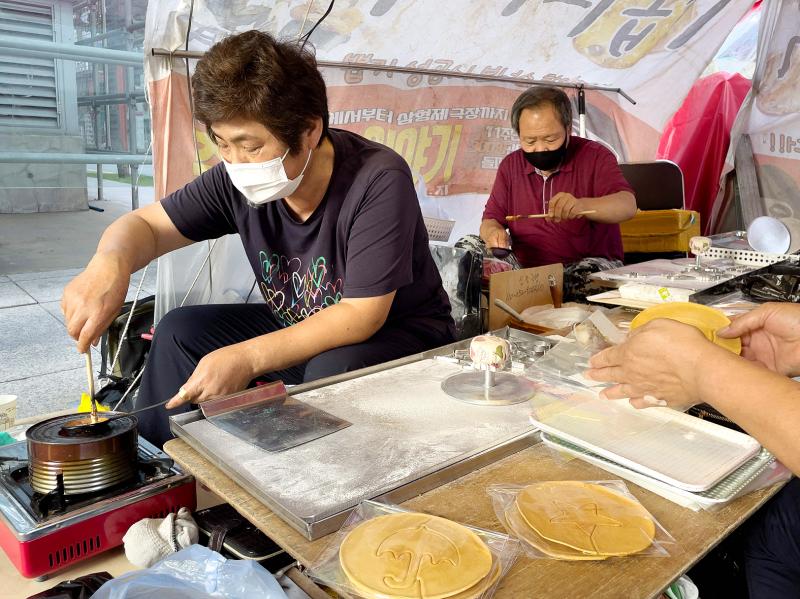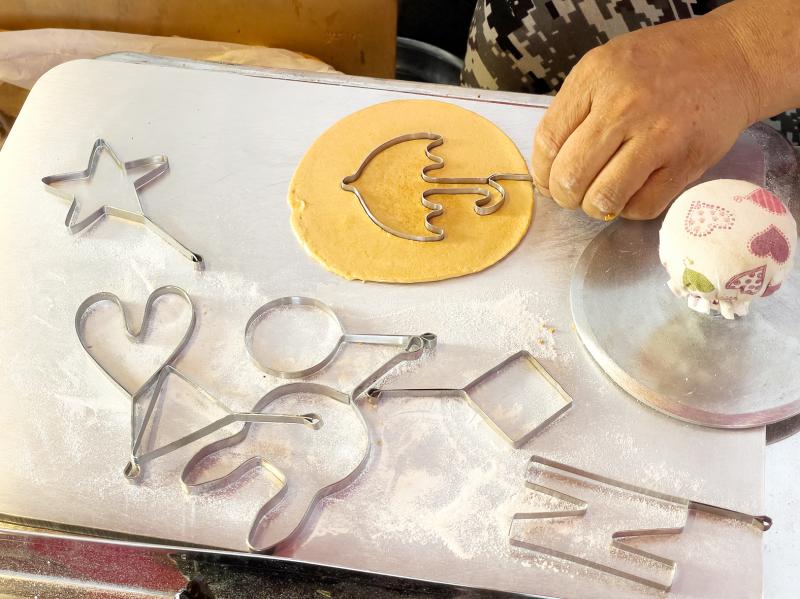Simple, sweet, and fictionally fatal: the stallholder who makes the traditional South Korean children’s treat featured in the global cultural phenomenon Squid Game — and once associated with post-war poverty — has hit a real-life jackpot.
The Netflix smash hit series features a group of South Korea’s most marginalised and deeply in debt, who compete in children’s games for the chance of 45.6 billion won (US$38 million), with lethal consequences.
In one particular challenge, the contestants try to cut out shapes including a star and an umbrella from a crisp sugar candy called a dalgona, without it cracking — and those who fail are killed.

Photo: AFP
The life-or-death game was inspired by director Hwang Dong-hyuk’s experience growing up in Seoul in the 1970s: but then, the prize for a child who successfully removed the shape was another free dalgona.
Hwang was always determined to win an extra treat and remembers employing multiple tactics in his efforts, including licking the candy to loosen the shape and using a needle heated over briquettes — techniques repeated in the show’s nail-biting dalgona challenge scene.
“I would make the dalgona maker extremely perplexed by succeeding on the most difficult shape of umbrella,” the director recently said in a YouTube video. But the candy was a difficult prop to manage on set as it softens easily, especially during South Korea’s humid rainy season, so Hwang and artistic director Chae Kyung-sun hired “dalgona experts” to have the candy freshly made on location.

Photo: AFP
Those specialists were Lim Chang-joo and his wife Jung Jung-soon, who produced between 300 and 400 dalgonas over three days of filming.
Now, their humble roadside stall in Seoul’s theatre district — little more than an umbrella, an awning and their equipment — is one of the hottest spots in the South Korean capital.
Orders for the 2,000-won (about US$1.70) sweets start piling up as soon as it opens, and before long, customers face six-hour waits, with some giving up and leaving empty-handed.
In about 90 seconds, Lim melts an individual portion of sugar above a burner, before adding baking soda, flattening it into a circle, and punching it with the customer’s preferred shape.
He offers a wider range of choices than the four forms in the show — and has a newly added “N” for Netflix.
“I never imagined it would become this popular,” Lim said of the series, adding that his life has now become “super hectic.”
“Of course, I’m happy because my business is doing well and how dalgona has become famous in other countries. I hope they make and eat their own dalgonas,” he added.
Historians say dalgona first emerged in the 1960s when the South was still assailed by post-war poverty while desserts — such as ice cream or chocolates — were not widely available and prohibitively expensive.
Very sweet, with hints of nuts and bitterness, the candy was hugely popular, with many vendors setting up their stalls near schools.
Lim and Jung started their dalgona operation with 30,000 won after closing their tailoring business of 20 years around the time of the 1997 Asian financial crisis.
The sweet endured throughout the South’s rise to become the world’s 12th-largest economy, following decades of rapid economic growth during the authoritarian rule of the post-war period.
And Squid Game is the latest manifestation of the ever-widening influence of the country’s popular culture, epitomized by K-pop sensation BTS and the Oscar-winning movie Parasite.
“South Korea has always been at the nexus of the modern and pre-modern, Western tools and Eastern ways, and preserving the past while sacrificing everything for the future,” said Michael Hurt, who teaches cultural theory at the Korea National University of Arts. “Dalgona is a nexus item in a nexus culture.”

Wooden houses wedged between concrete, crumbling brick facades with roofs gaping to the sky, and tiled art deco buildings down narrow alleyways: Taichung Central District’s (中區) aging architecture reveals both the allure and reality of the old downtown. From Indigenous settlement to capital under Qing Dynasty rule through to Japanese colonization, Taichung’s Central District holds a long and layered history. The bygone beauty of its streets once earned it the nickname “Little Kyoto.” Since the late eighties, however, the shifting of economic and government centers westward signaled a gradual decline in the area’s evolving fortunes. With the regeneration of the once

Even by the standards of Ukraine’s International Legion, which comprises volunteers from over 55 countries, Han has an unusual backstory. Born in Taichung, he grew up in Costa Rica — then one of Taiwan’s diplomatic allies — where a relative worked for the embassy. After attending an American international high school in San Jose, Costa Rica’s capital, Han — who prefers to use only his given name for OPSEC (operations security) reasons — moved to the US in his teens. He attended Penn State University before returning to Taiwan to work in the semiconductor industry in Kaohsiung, where he

On May 2, Chinese Nationalist Party (KMT) Chairman Eric Chu (朱立倫), at a meeting in support of Taipei city councilors at party headquarters, compared President William Lai (賴清德) to Hitler. Chu claimed that unlike any other democracy worldwide in history, no other leader was rooting out opposing parties like Lai and the Democratic Progressive Party (DPP). That his statements are wildly inaccurate was not the point. It was a rallying cry, not a history lesson. This was intentional to provoke the international diplomatic community into a response, which was promptly provided. Both the German and Israeli offices issued statements on Facebook

Perched on Thailand’s border with Myanmar, Arunothai is a dusty crossroads town, a nowheresville that could be the setting of some Southeast Asian spaghetti Western. Its main street is the final, dead-end section of the two-lane highway from Chiang Mai, Thailand’s second largest city 120kms south, and the heart of the kingdom’s mountainous north. At the town boundary, a Chinese-style arch capped with dragons also bears Thai script declaring fealty to Bangkok’s royal family: “Long live the King!” Further on, Chinese lanterns line the main street, and on the hillsides, courtyard homes sit among warrens of narrow, winding alleyways and